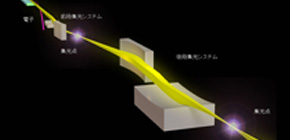
Power density of hard X-ray laser pulses increased by a factor in excess of 100
Achieved an extraordinary power density
As shown in the imaging of internal nanostructures of living cells ( press release in January 2014 ) and special X-ray non-linear signals ( press release in February 2014 ), at SACLA, facility for generating strong X-ray laser, X-ray Free Electron Laser (XFEL), the "impossible to observe" became possible. SACLA generated a micro beam with ultra-precise mirrors using ultraprecision machining technology and achieved the strongest power density 6×10 17 W/cm 2 , a world first ( press release in December 2012 ). However, some physical phenomena cannot be observed with such power density so they developed a complicated system enabling highly tunable enhanced power density.
In cameras and microscopes, several lenses and mirrors are used to control the amount of light, viewing field, and resolution power; however, in a short-length x-ray laser, it is necessary to use ultra-precise mirrors with a high degree of accuracy. Therefore, a complicated system using mirrors like the ones in cameras has not been employed.
In cooperation with Japan Synchrotron Radiation Research Institute and Riken, a group of researchers led by MIMURA Hidekazu (Associate Professor, The Graduate School of Engineering, The University of Tokyo) and YAMAUCHI Kazuto (Professor, The Graduate School of Engineering, Osaka University) succeeded in focusing XFEL pulses to a spot 30 x 50 nm in size by making use of four ultra-precise mirrors at SACLA.
This group also confirmed creation of an X-ray laser beam with an extraordinary power density of over 10 20 W/cm 2 , a world first. This group designed an optical system (two-stage reflective focusing system) using 4 elliptically curved mirrors. In order to focus XFEL pulses to nano size, it was necessary to magnify the XFEL pulses to the theoretical limit. So this group expanded XFEL pulses by using two converging mirrors placed on one stage and focusing the expanded pulses by two converging mirrors placed on the other stage.
At SACLA, this group developed a ultra-precise mirror tuning device and an X-ray wavefront system for measuring wavefront profiles of XFEL pulses instantly. The group adjusted the intensity and angles of four converging mirrors and confirmed achievement of a focal spot size of 30 x 50 nm in experiments.
This group achieved power density of 10 20 W/cm 2 hard X-ray laser pulses. Making use of such may lead to the discovery of unknown physical phenomena in basic physics fields such as cosmic physics, high-energy physics, and quantum optics. This group's achievement makes a great contribution to the development of atomic resolution microscopes for living substances necessary in research in medicine and drug development.
Abstract
Intense X-ray fields produced with hard X-ray free-electron laser (XFEL) have made possible the study of nonlinear X-ray phenomena. However, the observable phenomena are still limited by the power density. Here, we present a two-stage focusing system consisting of ultra-precise mirrors, which can generate an extremely intense X-ray field. The XFEL beam, enlarged with upstream optics, is focused with downstream optics that have high numerical aperture. A grating interferometer is used to monitor the wavefront to achieve optimum focusing. Finally, we generate an extremely small spot of 30 × 55 nm with an extraordinary power density of over 1 × 10 20 W cm −2 using 9.9 keV XFEL light. The achieved power density provides novel opportunities to elucidate unexplored nonlinear phenomena in the X-ray region, which will advance development on quantum X-ray optics, astronomical physics and high-energy density science.

Figure 1

Figure 2

Figure 3

Figure 4
To learn more about this research, please read the full research report entitled "Generation of 10 20 Wcm -2 hard X-ray laser pulses with two-stage reflective focusing system" at this page of Nature Communications website.
Related links :
